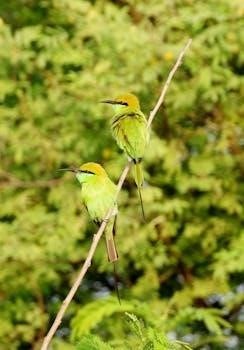Embark on a journey to capture the beauty of birds through art! This guide provides a structured approach, covering basic shapes, shading techniques, and step-by-step tutorials. Learn to draw various bird species with ease and precision.
Bird drawing is a fantastic way for beginner artists to develop observation skills. Their diverse shapes and markings offer a versatile starting point for learning. This guide simplifies the process, making it less daunting and more enjoyable. We will explore techniques to understand form and refine details.
Drawing from photos allows ample time to study shapes and patterns without the distraction of movement. Consider creating study drawings to replicate intricate details. Join us as we sketch various birds, including songbirds, owls, hawks, and cardinals. This guide uses easy steps, perfect for beginners.
Mastering bird drawing involves understanding basic shapes, lines, and shading. We’ll cover step-by-step instructions, materials needed like graphite powder, soft brushes, and pencils. Learn realistic bird drawing easily and have fun!
Basic Bird Anatomy for Artists
Understanding bird anatomy is crucial for realistic drawings. This section breaks down the essential skeletal structure, muscle placement, and feather arrangements. Learn to depict accurate and lifelike avian forms with confidence.
Understanding Proportions
Mastering proportions is vital for creating believable bird drawings. Birds possess unique body ratios that, when accurately represented, contribute significantly to the realism of your artwork. Start by observing the relationship between the head, body, wings, and tail.
A common technique involves using the head as a unit of measurement. Determine how many “head lengths” fit into the overall body length. This ratio varies across species, so careful observation is key. Consider the wing-to-body ratio as well.
Pay attention to the placement of joints, such as the shoulder, elbow, and wrist, as these dictate the posture and movement of the bird. Practice sketching simple bird shapes, focusing solely on getting the proportions correct before adding details. Remember, accurate proportions are the foundation of a convincing bird drawing.
Feather Structure and Types
Understanding feather structure is essential for rendering realistic plumage. Feathers aren’t uniform; they vary in size, shape, and function across a bird’s body. Contour feathers, which cover the body, provide the bird’s streamlined shape. Flight feathers, found on the wings and tail, are crucial for flight.
Down feathers, located beneath the contour feathers, provide insulation. Each feather consists of a central shaft (rachis) and barbs that interlock to form a smooth vane. Learn to differentiate between these feather types and how they overlap.
Observe how light interacts with feathers, creating highlights and shadows. Pay attention to the direction of feather growth, as this affects the overall texture. Practice drawing individual feathers and feather groups to develop a feel for their structure and arrangement. Mastering feather depiction elevates your bird drawings to a new level of realism.

Essential Drawing Materials
Selecting the right tools is crucial. Essential materials include a range of graphite pencils for sketching and shading, quality paper suitable for detailed work, erasers, and blending tools. These will bring your bird drawings to life.
Pencils and Graphite Grades
Understanding pencil grades is fundamental for achieving various tonal values in your bird drawings. H pencils are hard and create light, precise lines, ideal for initial sketches. Softer B pencils, ranging from 2B to 6B or higher, produce darker, richer tones perfect for shading and adding depth.
Experiment with different grades to understand their effects on paper. Using a combination of H and B pencils allows for controlled linework and subtle gradations in shading, essential for rendering realistic feather textures and defining the form of your avian subjects. Consider using graphite powder applied with a soft brush for smooth, even tones.
Paper Types for Bird Illustration
The choice of paper significantly impacts the final outcome of your bird illustration. Smooth paper, like Bristol board, is excellent for detailed linework and precise rendering, allowing for clean, sharp lines. Textured paper, such as watercolor paper or drawing paper with a slight tooth, is ideal for capturing feather textures and creating depth through shading.
Consider the weight of the paper; heavier paper (at least 90lb) can withstand multiple layers of graphite or colored pencils without buckling. Experiment with different paper types to discover which best suits your drawing style and the desired level of detail in your bird illustrations.

Step-by-Step Drawing Tutorials
Follow these simple instructions to create stunning bird drawings. Learn to construct basic shapes, add details like beaks and eyes, and refine your artwork with shading. Start drawing birds today!
Drawing a Simple Bird Shape
Begin your bird drawing journey by mastering the fundamental shapes; Start with simple circles and ovals to represent the bird’s body and head. These basic forms provide the foundation for a realistic representation, ensuring proper proportions and structure. Lightly sketch these shapes, allowing for easy adjustments as you refine your drawing.
Connect the head and body with a curved line to form the neck, paying attention to the bird’s posture. Observe the reference image closely to accurately capture the angle and length of the neck. As you add detail, remember to keep your lines loose and fluid. This approach will help you create a natural and dynamic bird drawing. Focus on capturing the essence of the bird before moving on to details. This technique will make the process much easier and more rewarding.
Adding Details⁚ Beak, Eyes, and Feet
Once you have the basic shape, it’s time to add defining details like the beak, eyes, and feet. The beak’s shape varies greatly among bird species, so observe your reference carefully. Sketch the beak with precise lines, paying attention to its length, curve, and angle. The eyes are crucial for conveying expression; draw them as small circles or ovals, adding a highlight to bring them to life.
The feet can be simplified into basic shapes initially, then refined with details like claws and scales. Remember that bird feet are often partially hidden by feathers, so don’t feel obligated to draw every detail. Focus on accurately capturing the essential features that make each bird unique, enhancing the overall realism.

Advanced Techniques
Elevate your bird drawings with advanced shading and texture techniques. Learn to render feathers realistically, creating depth and dimension. Explore methods for capturing lifelike details, enhancing the overall artistic impact of your work.
Shading and Rendering Feathers
Mastering feather shading is crucial for realistic bird drawings. Begin by observing the direction and intensity of light on real feathers or high-quality references. Use graphite pencils of varying grades to create subtle tonal shifts, mimicking the natural contours and textures.
Employ techniques like hatching, cross-hatching, and blending to build up layers of shading gradually. Pay close attention to the barbules and rachis of each feather, adding fine lines to represent their structure.
Highlighting is equally important. Use a kneaded eraser to lift graphite and create areas of bright reflection. Experiment with different blending tools, such as stumps or tortillions, to achieve smooth transitions between light and shadow. Consider the overlapping of feathers to create a sense of depth and realism in your drawings.
Creating Realistic Textures
Achieving realism in bird drawings hinges on capturing diverse textures. For feathers, use a combination of fine lines, stippling, and directional strokes to mimic the varying surfaces. Observe how light interacts with different feather types, from the smooth contours of flight feathers to the fluffy down feathers.
For beaks and claws, emphasize hardness through sharp lines and subtle highlights. Use cross-hatching to create depth and form. When drawing eyes, focus on capturing the glint of light to bring them to life.
Consider the texture of the bird’s legs and feet. Use subtle variations in tone and line weight to suggest scales or rough skin. Experiment with different paper surfaces to enhance the overall texture. A textured paper can add visual interest and depth to your drawing, making it appear more lifelike.
Drawing Birds in Different Poses
Explore the dynamics of avian movement! Learn to capture the essence of birds in flight and at rest. Master the art of portraying birds perched gracefully or soaring through the sky with elegance and precision.
Flying Birds
Drawing birds in flight presents a unique challenge, requiring an understanding of aerodynamics and anatomy. Pay close attention to the wing positions, as they dictate the bird’s movement. Observe how the wings curve and flex, generating lift and thrust. The body should be streamlined, reducing air resistance.
Consider the angle of the bird’s body relative to the wings, indicating whether it’s soaring, flapping, or diving. Capture the dynamic energy of the bird in motion by exaggerating the wing positions and creating a sense of speed. Note how feathers overlap and create intricate patterns during flight, adding realism to your drawing. Remember the slight tilt of the head that helps with balance in the air. Practice capturing the freedom and grace of birds in flight!
Perched Birds
Drawing perched birds involves capturing a sense of stillness and balance. Observe how the bird’s weight is distributed on its feet and the branch. Pay attention to the angle of the legs and the grip of the claws, which provide stability. The body should be relaxed, with feathers slightly ruffled.
Consider the posture of the bird, whether it’s alert and upright or relaxed and hunched over. Capture the subtle curves of the body and the delicate details of the feathers. Notice how the head is often tilted, adding character to the drawing. Observe the way the tail feathers provide balance. Consider adding the texture of the bark that is on the branch the bird is perched on. Practice creating realistic perched bird drawings by focusing on the subtle details and natural poses.

Drawing Different Bird Species
Explore the diverse world of birds by learning to draw various species. Each bird possesses unique characteristics, from songbirds with vibrant plumage to birds of prey with sharp features. Master the art of capturing their individual beauty.
Songbirds
Songbirds are renowned for their melodious voices and vibrant colors, making them captivating subjects for artists. Their small size and intricate plumage present unique challenges and opportunities for detailed drawing. To accurately depict songbirds, focus on capturing their delicate features, such as their slender beaks, expressive eyes, and the subtle variations in their feather patterns.
Start by sketching the basic shapes of the bird’s body, paying close attention to proportions. Observe the specific characteristics of different songbird species, like the robin’s red breast or the blue jay’s striking blue feathers. Use light, flowing lines to create a sense of movement and vitality. Experiment with color pencils to bring out the vibrancy and beauty of these feathered musicians.
Birds of Prey
Birds of prey, such as eagles, hawks, and owls, embody power and majesty, providing artists with compelling subjects. When drawing these magnificent creatures, emphasize their sharp talons, piercing eyes, and formidable beaks. Begin by outlining the bird’s overall form, paying close attention to its wingspan and body proportions.
Capture the intensity in their gaze by focusing on the details around the eyes, using shading to create depth and realism. Pay attention to the texture of their feathers, using fine lines to simulate the layering and overlapping patterns. Study reference images to accurately depict the unique characteristics of different birds of prey, such as the bald eagle’s white head or the owl’s distinctive facial disc. Employ bold strokes and dark values to convey their strength and dominance.
